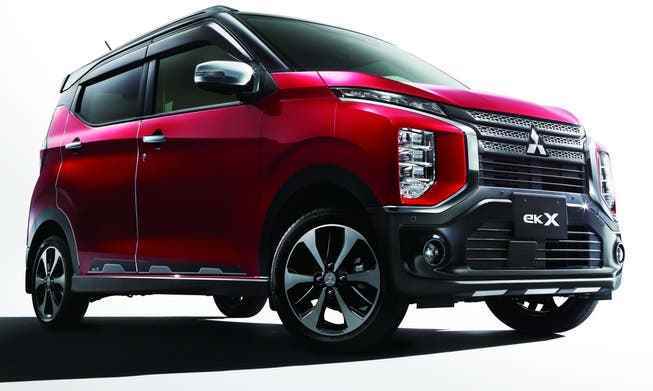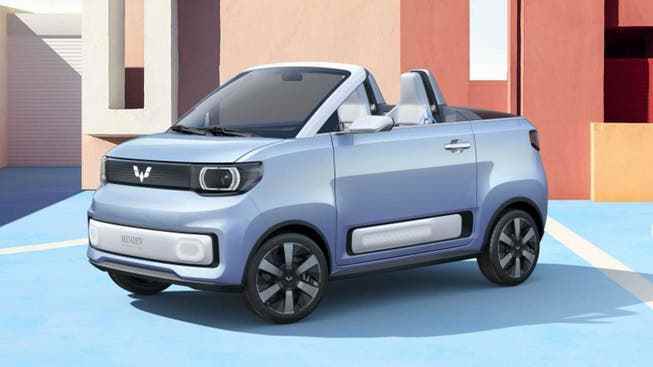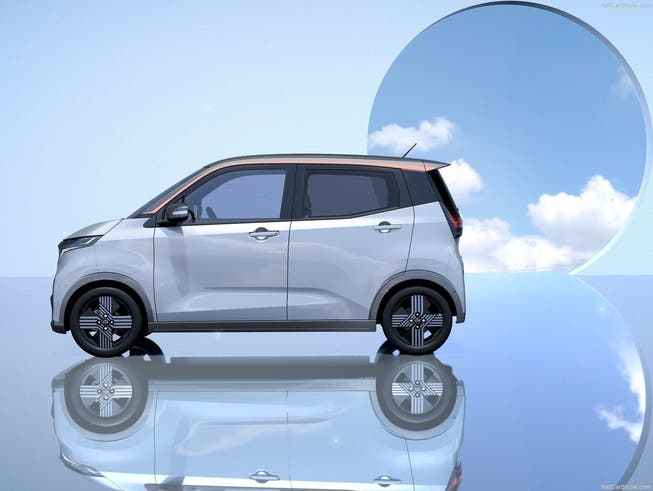Japan’s automakers are bringing affordable electric cars onto the market. While Renault’s allies are focusing on cars, a Toyota consortium is planning cheap trucks.
The Nissan Sakura is intended to appeal to Japanese customers as a low-cost electric car in kei-car format.
Tesla has promised an affordable electric car, the Japanese carmaker Nissan is already delivering it. The entry-level four-seater costs about 12,000 euros (1.7 million yen), after deducting government subsidies. This is about as much as a well-appointed Mini. The full version, equipped with a 360-degree view and driving assistants for semi-autonomous driving in one lane of the motorway, will then be available in the catalog for 21,000 euros – without state subsidies.
Sakura (cherry blossom) is the name of the model that Nissan has developed together with its partner Mitsubishi Motors. He calls his version eK X. Both belong to the large segment of small cars in Japan, the kei cars with a maximum length of 3.40 meters, 1.48 meters width and 660 cubic centimeter combustion engines with 64 hp. And they are just the harbingers of a strategy by Japanese manufacturers to not only approach the electric car market from the upper price segment, but also from below – and thus to fight against possible rivals from China at home and also in emerging countries.

The Mitsubishi version eK X differs from the Nissan Sakura only in the front area and in a few details.
The business model of the cheap electric car was first tested in China with the Wuling Hong Guang Mini, explains the car analyst Chris Richter from the CLSA in Tokyo. The simple mobile, which cost a few thousand euros, was sold there in large numbers. “Nissan and Mitsubishi have adapted the idea for Japan,” says Richter. “So you’ve learned a lot that can be transferred to emerging markets, where costs also play a big role.”
A Toyota consortium is planning the electric mini truck
The Renault partners are not alone in this attempt. The Commercial Japan Partnership Technologies Corporation (CJPT), a consortium led by Toyota with the Toyota subsidiary Daihatsu, the small car specialist Suzuki and the commercial vehicle manufacturer Isuzu, wants to develop a kei truck for the logistics companies by 2023. Toyota’s commercial vehicle subsidiary Hino will also take part once it has overcome its emissions scandal. The company was temporarily banned from CJPT precisely because of one such. The price of the model has not yet been determined.
However, Nissan is already pursuing a multi-layered strategy. Its Leaf, which has been available since 2011, is in the middle class, while the new Ariya crossover is a segment higher. Riho Suzuki, the product manager for the Sakura, now explains which recipes they used to minimize the price of the mini. “It was a very difficult task for us to meet the requirements in terms of equipment and price,” the manager recalls.
The goal was high: With the Sakura, Nissan wants to open up the market for affordable electric cars, which has previously been dominated by hybrids. Therefore, the team checked every detail to save all unnecessary costs, according to Suzuki. The most important was the battery, the most expensive component of an electric car.
First they used the battery technology of Nissan’s electric car Leaf, which is already buzzing on the streets in the second generation. In addition, they halved the battery size of the cheapest Leaf to 20 kilowatt hours.
This means that the Sakura can travel around 180 kilometers on one charge. But that’s enough for kei cars, which are mostly used for relatively short trips around town or in the country, says Suzuki. “In our opinion, this size has a good balance between daily use and costs.”

The electric Wuling Hong Guang Mini from China gave Nissan the idea for a cheap micro-electric vehicle.
Driving fun with little horsepower
A driving test in Yokohama shows that a small engine combined with a small battery is definitely fun to drive in the city. Because the Sakura only weighs a little more than a ton – and thus about 50 percent less than the standard version of a Tesla Model 3. With a courageous step on the gas pedal, the author has already lost a 5-series BMW taxi at the traffic light, since with electric cars unlike with combustion engines, the engine puts full power on the road right from the start.
The car analyst Richter sees the biggest difference to Tesla’s unfulfilled promise and the strategy of the established car manufacturers in this courage to enter a niche. “Right now, most western manufacturers are focusing on the same thing as Tesla,” explains Richter, “a one-size-fits-all solution that’s useful for everyone, but expensive.”
At Tesla, he still has the greatest understanding of this. The company is small and must therefore first concentrate on standard models that will find as many buyers as possible. “A large manufacturer that already caters to a wide range of customers can focus on niches much more easily than a much smaller brand like Tesla.”
Small cars, big segment: why Nissan is attacking minis
The advance was made easier for Nissan and Mitsubishi Motors by the fact that the partners not only use existing technology. They also have their sights set on an already fairly large segment that is particularly well-suited to electrification. A total of 31 million kei cars drive on Japan’s roads. That’s around 40 percent of the entire portfolio. In addition, they are particularly common in rural areas and in the suburbs.
There they avoid an obstacle that slows down electric cars in the big cities: City dwellers shy away from buying pure electric cars because only a few of the paid parking spaces in apartment blocks or private parking providers offer electricity connections. In rural areas, however, the small battery size, combined with the widespread single-family homes, makes charging at home easier, so that customers hardly have to go to charging stations.
In addition, kei car drivers in particular often do not drive long distances. Anyone who wants to travel usually takes the punctual and fast train anyway, because long-distance journeys by car are expensive due to the kilometer-based toll.

The Nissan Sakura and its model brother Mitsubishi eK X should help the electric car to make a breakthrough in Japan.
Secondly, kei cars are also important in local logistics as inexpensive delivery vehicles in local traffic. They are particularly popular with self-employed drivers and small businesses with fewer than 20 employees, who make up 70 percent of the 60,000 logistics companies. Daihatsu boss Soichiro Okudaira therefore said last year when the CJPT consortium was founded: “We will start our efforts with commercial vehicles.”
At the same time, hurry is required, because the competition from China never sleeps. The Chinese conglomerate BYD (Build Your Dreams) wants to start with electric cars in Japan at the beginning of 2023 – specifically for passenger cars. The Japanese start-up ASF wants to come onto the market for mini trucks with models designed in Japan and built in China. However, it is still unclear when.
CJPT has now launched a new development initiative to further reduce the cost of electric bonsai trucks. They are reviewing the development of replaceable battery cartridges to reduce the burden on both the power grid and businesses. The partners not only promise their customers that they can avoid long battery charging times by exchanging batteries quickly. The logistics companies should be able to adapt the battery capacity to their needs, even for trucks of different sizes.
